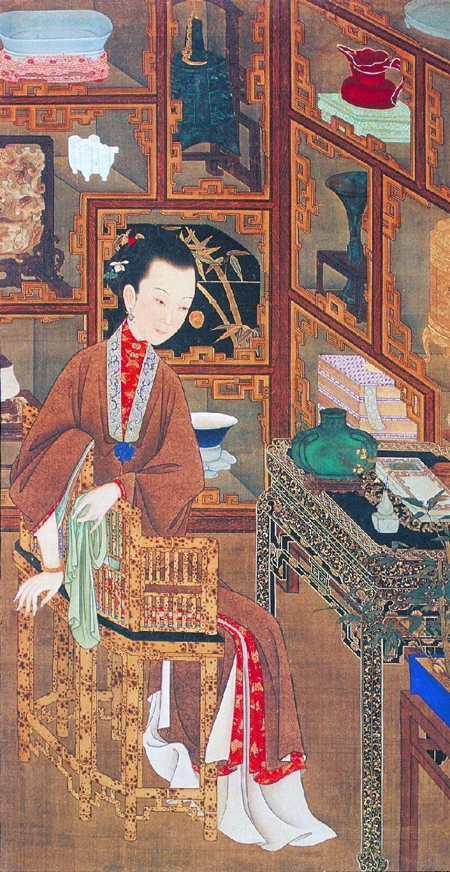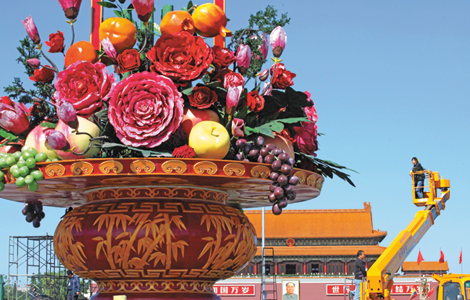Search for a cup holder's identity
Updated: 2013-10-05 00:33
By Zhang Zixuan (China Daily)
|
||||||||
 |
|
Ru Kiln cup holder seen in one of the 12 Beauties paintings by court painters of the Qing Dynasty. |
The air bubbles show difference
This conclusion is seconded by a former director of the National Museum of Korea and a celebrated Korean celadon expert, Chung Yang-mo, who came to Beijing specifically to get a look at the cup holder.
The 82-year-old Chung, who has excavated hundreds of pieces of Korean celadon ware, comments, "Although porcelain making was introduced to Korea during the Five Dynasties and Ten Kingdoms period (AD 907-979), there are some techniques for cup holders of this kind that Korean celadon makers never learned."
The first discrepancy is the petal flange, which is almost horizontal, while similar flanges on Korean celadon are upturned at the edge, otherwise the flange would collapse during the firing process, he explains.
Second, Korean celadon contains more ferrum, which oozes through during the firing to add redness to the color. This cup holder on the other hand is a grayish green.
What is more important, however, are the air bubbles. In the Korean celadon glaze, they are mixed together in different sizes. But this cup holder has very even air bubbles that are distributed like pearls.
"That's why it's so lucid and beautiful," Chung continues enthusiastically, adding. "I feel honored just holding it."
Adding support to this is Choi Kun, the former director of the Gyeonggi Ceramic Museum in South Korea and a Korean celadon expert who accompanied Chung on the Beijing adventure, and who explains, "The porcelain body is more exquisite and was fired at a higher temperature."
The two specialists also point out that the copper inlay technique has to be Chinese because it had not been mastered by the Korean craftsmen of the time.
Lu Chenglong, the Beijing Palace Museum's Ancient Ceramics Department head, says the copper inlay was probably done much later by the Japanese, considering that the auction item is from a Japanese collector. He then speculates, "It's possible that the copper was inlaid to cover chipped areas on the upper edge, or to prevent chipping."
Nonetheless, he is quite certain that this ware is a product of the Ru Kiln at the Qing-liang Temple.

 Victoria Beckham S/S 2014 presented during NYFW
Victoria Beckham S/S 2014 presented during NYFW
 'Despicable' minions upset Depp's 'Lone Ranger' at box office
'Despicable' minions upset Depp's 'Lone Ranger' at box office
 'Taken 2' grabs movie box office crown
'Taken 2' grabs movie box office crown
 Rihanna's 'Diamonds' tops UK pop chart
Rihanna's 'Diamonds' tops UK pop chart
 Fans get look at vintage Rolling Stones
Fans get look at vintage Rolling Stones
 Celebrities attend Power of Women event
Celebrities attend Power of Women event
 Ang Lee breaks 'every rule' to make unlikely new Life of Pi film
Ang Lee breaks 'every rule' to make unlikely new Life of Pi film
 Rihanna almost thrown out of nightclub
Rihanna almost thrown out of nightclub
Most Viewed
Editor's Picks

|

|

|

|

|

|
Today's Top News
US military conducts successful missile defense test
US House Speaker says US needs to address spending problem
Trending news across China on Oct 4
President Xi meets Malaysian PM on ties
DC shutdown gets social media all in a twitter
Hotels aside, AVIC needs to grow its service arm
Gunfire forces brief lockdown at US Capitol
Mutual help the best: IMF chief
US Weekly

|

|







